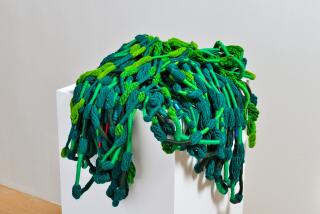AROUND HOME : Collecting Quilts
- Share via
THE CRAFT OF making patchwork quilts is often thought of as being characteristically American, although this is not really the case. The use of scraps of material to make decorative coverings goes back many centuries, not only in this country but in Europe and Asia. Over the years, quilt making grew in sophistication, and what was once simply a popular household craft became an admired art.
Long before decorative quilting appeared in Europe, the people of China, India and the Middle East were using padded fabrics for clothing, bedding and even armor. With the arrival of European settlers in the New World, however, the decorative craft as we now know it developed and began to flourish. The first colonists had little to work with in the way of materials, and it became a habit to hoard every scrap of fabric. In this way, the bedcovering served as a family record, and the making of it turned into a social occasion with quilting parties and quilting bees.
Basically, the quilt itself is made up of two pieces of fabric with a filling between. The upper layer is decorative, the bottom utilitarian; the filling provides warmth and thickness.
Quilts in America are divided into a number of traditional types: patchwork, applique and embroidered. And there are many special categories. The wonderful crazy quilt, for example, reached its height during the Victorian era. Irregularly shaped pieces of material (made of colorful scraps of silk, brocade, velvet, satin and taffeta) were pieced together in blocks that were later joined. The album quilt, with its charming illustrations, was characteristic of Baltimore around 1850, and there were patriotic, commemorative and political quilts honoring many periods of American history.
Perhaps the most artistic and decorative of all are the geometric quilts produced by Mennonites, who settled in Pennsylvania and the Midwest and, in particular, by members of one dissident sect, the Amish. The Pennsylvania Amish made their quilts mostly from light wool, whereas in the Midwest cotton was the typical material. Amish quilts are much admired for their simple, stylish and colorful patterns such as diamond-in-a-square and nine-patch. Scarcest of all collectible quilts are those made in Hawaii, where the work was influenced both by settlers and native artisans. Early island textiles were made from a paperlike fabric produced from the bark of trees, and many motifs were based on the Hawaiian flag.
Collecting quilts is a popular and increasingly expensive hobby, and collectors have found many ways to exhibit their treasures--most often as art on the walls. The modern quilt (and the strikingly contemporary Amish quilt) lend themselves particularly well to this sort of presentation.
Quilts can be found at The Quilt Gallery in Santa Monica; Main St. U.S.A. in Venice; Margaret Cavigga in West Los Angeles; Sherwoods Spirit of America in Beverly Hills; Pasadena Antique Center in Pasadena; Wild Goose Chase Folk Art Americana Quilts in Santa Ana; Uncle Tom’s Antiques in Orange; Molly’s Cupboard in Solvang; The Snow Goose and Norma Dee Antiques in La Jolla, and The Connoisseur in San Diego.
The American Quilt Research Center at the Los Angeles County Museum of Art can be consulted by appointment only; telephone (213) 857-6083.


